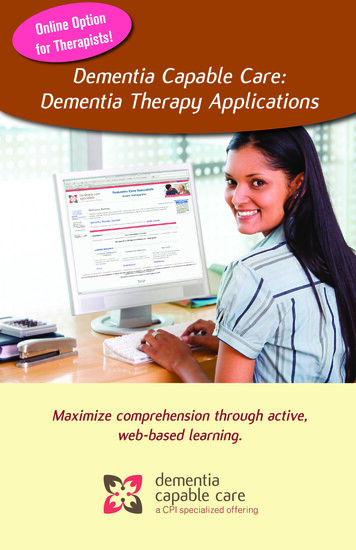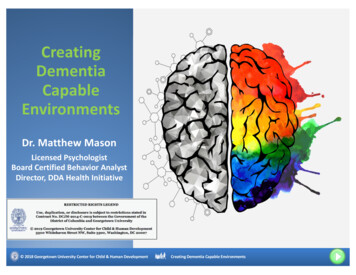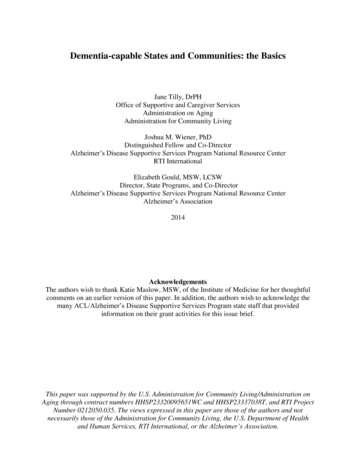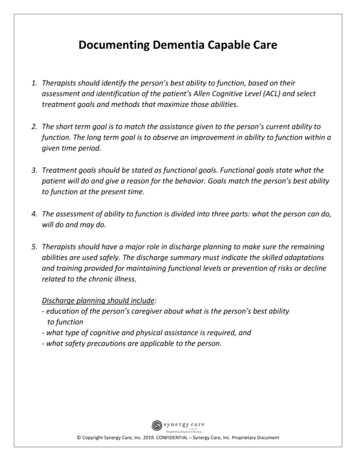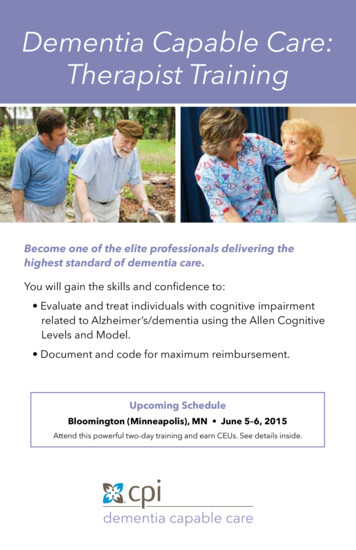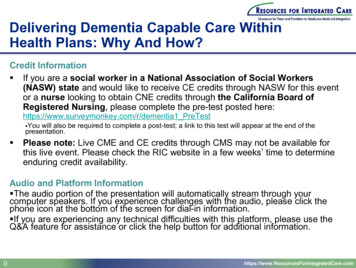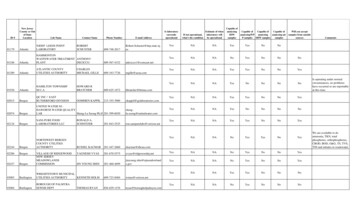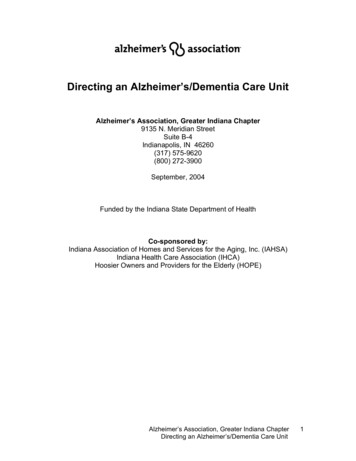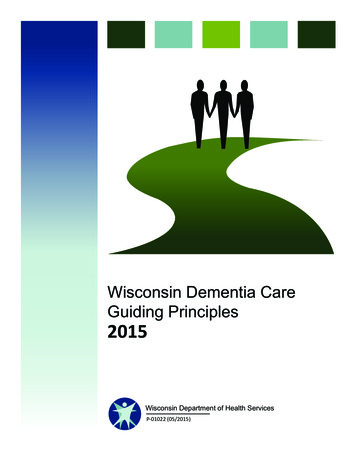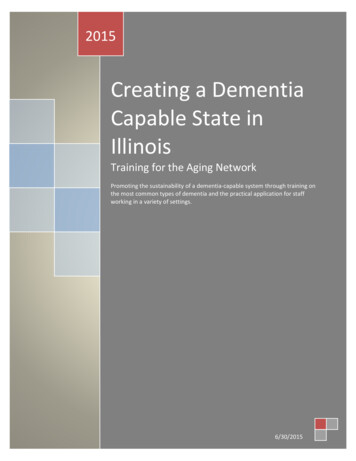
Transcription
2015Creating a DementiaCapable State inIllinoisTraining for the Aging NetworkPromoting the sustainability of a dementia-capable system through training onthe most common types of dementia and the practical application for staffworking in a variety of settings.6/30/2015
PrefaceCREATING A DEMENTIA CAPABLE STATE IN ILLINOISThe Illinois Department on Aging, in partnership with other state agencies, Alzheimer’sAssociation Chapters, Area Agencies on Aging, the Illinois Council of Care Coordination Unitsand other key stakeholders is expanding a statewide coordinated dementia-capable systemthat builds on the service infrastructure currently in place. The goal of this expansion is todevelop and implement a sustainable, community-based service delivery system in that meetsthe needs of individuals with dementia and the needs of their caregivers; a dementia-capablesystem. This expansion includes training the Aging Network on the components of a dementiacapable service delivery system.The Aging Network in Illinois that cares for individuals with dementia includes CareCoordinators, Adult Protective Service Workers, in-home care workers, adult day serviceworkers, Area Agency on Aging staff, Aging and Disability Resource Center staff, managed careorganization staff and supportive living facility staff. These providers need accurate informationabout caring for someone with dementia including the benefits of early diagnosis, how toaddress the physical, cognitive, emotional, and behavioral symptoms of the disease, and how toassist caregivers as they cope with the physical and emotional aspects of their caregivingresponsibilities. Dementia-specific capabilities within the direct care workforce need to beenhanced.With a grant from the Illinois Department on Aging, the Illinois Council of Care CoordinationUnits focused on the training component to promote the sustainability of a dementia-capablesystem. This training manual is a piece of this training effort to strengthen the dementiacapability of a workforce providing care to people with dementia.1
ACKNOWLEDGEMENTSThis training curriculum was developed by the Illinois Department on Aging and the IllinoisCouncil of Care Coordination Units. Excerpts were taken from a previous edition of theAlzheimer’s Disease Training Manual also developed by the Illinois Council of Care CoordinationUnits.The training manual was written by:Julie Farmer, LCSWProgram Director, Alternatives [for the Older Adult]Co-Chairperson of the Education Committee, ICCCUDarby Morhardt, Ph.D., LCSWCognitive Neurology and Alzheimer’s Disease CenterNorthwestern University, Feinberg School of MedicineThank you to the following individuals for their contributions and editorial review:Jeanette Piper, Senior Services of Will CountyCo-Chairperson of the Education Committee, ICCCUTeva Shirley, Southwestern Illinois Visiting Nurses AssociationPresident-Elect of the ICCCUKathy Weiman, Alternatives [for the Older Adult]Past President of the ICCCUMarsha Nelson, Shawnee Alliance for SeniorsMember of the Education Committee of the ICCCUDebbie Bailey, Senior Services of Central IllinoisMember of the Education Committee of the ICCCU2
TABLE OF CONTENTSPreface. . . . . . . . . . . . . . . . . . . . . . . . . . . . . . . . . . . . . . . . . . . . . . . . . . . . . . . . . . . . . . .Acknowledgements. . . . . . . . . . . . . . . . . . . . . . . . . . . . . . . . . . . . . . . . . . . . . . . . . . . .12Section 144679DEMENTIADefinition, Types and IncidenceMild Cognitive ImpairmentDementia StagesReversible/Treatable Causes of dementiaSection 2ALZHEIMER’S DISEASENormal Memory Problems vs. Alzheimer’s1113Section 3VASCULAR DEMENTIA14Section 4DEMENTIA WITH LEWY BODIESManagement of Symptoms1618Section 5FRONTOTEMPORAL LOBE DEMENTIA19Section 6COMMUNICATION21Section 7WORKING WITH THE CAREGIVER23Section 8CAREGIVERS26Section 9RESOURCES/LINKS28BIBLIOGRAPHY303
SECTION 1WHAT IS DEMENTIA?The term dementia is not a specific disease. Dementia is used to describe the gradualdeterioration of “intellectual” abilities and behavior that eventually interferes with customarydaily living activities. Customary daily living activities include balancing the checkbook, keepinghouse, driving the car, involvement in social activities, and working at one’s usual occupation.There may also be changes in personality and emotions. Contrary to popular belief, dementia isnot a normal outcome of aging, but is caused by diseases that affect the brain. Dementiainfluences all aspects of mind and behavior, including memory, judgment, language,concentration, visual perception, temperament and social interactions. The Diagnostic andStatistical Manual (DSM 5) states that at least one or more of the following cognitive domainsmust be significantly impaired to be considered dementia (or neurocognitive disorder): Complex Attention (sustained attention, divided attention, selective attention,processing speed) Executive Function (planning, decision making, working, memory, responding tofeedback/error correction, overriding habits/inhibition, mental flexibility) Learning and Memory (immediate memory, recent memory, very long termmemory) Language (expressive language including naming, word finding, fluency, andgrammar, and syntax; and receptive language) Perceptual-motor Social cognition (recognition of emotions, theory of mind; often described as achange in personality)While there are at least a hundred types of dementias, this Training Manual will provideadditional information on the 4 most common types of dementia in order of prevalence: Alzheimer’s Disease - 11% of the population affected (5 million) and up to 60 to80% of those over age 65 Vascular Dementia - up to 20% of all dementias Lewy Body Dementia (LBD) - 20% of individuals with dementiaIncludes sub-diagnoses of:Dementia with Lewy Bodies4
Parkinson’s Disease Dementia Frontotemporal Dementia (FTD) - 2%-10% of all dementias)Includes sub-diagnoses of:Behavioral variant frontotemporal dementiaPick’s DiseasePrimary Progressive AphasiaCorticobasal SyndromeProgressive supranuclear palsyFrontotemporal dementia with parkinsonismFrontotemporal dementia with amyotrophic lateral sclerosisOther less common types of dementia include: Dementia Pugilistica due to traumatic head injury (moderate head trauma isrelated to twice the risk of developing AD or other dementias as someone whohad no head trauma)[2014 Alzheimer’s Disease Facts and Figures p. 11] HIV associated dementia (HAD) Normal pressure hydrocephalus (excess cerebrospinal fluid accumulates inbrain’s ventricles) Huntington’s Disease (symptoms usually show up between ages 30-50) Creutzfeldt-Jakob Disease (a prion disease, is rare with sudden onset) Wernicke-Korsakoff Syndrome (severe deficiency of thiamine commonly causedby alcohol misuse) Mixed Dementia (2 or more dementias)To see how the brain is affected in these types of dementia, open the followinghyperlink: http://www.medicinenet.com/dementia pictures slideshow/article.htmDementia is caused by damage to brain cells which disrupts the ability of those cells tocommunicate with one another. The area of the brain that is damaged determines thediagnosis and progression of symptoms. Not all symptoms happen to all people and mostdementias progress over time. Medications may help with managing various symptoms for aperiod of time.Frequently, increased difficulty with memory and other areas of cognition are key symptomswhich will prompt an evaluation by a physician. Unless the individual or family memberexpresses concern, a physician will not always be able to perceive a problem during the early5
stages. Individuals may not display any memory or cognitive deficits in general conversation orduring a short visit in the physician’s office. As well, typical medical tests performed in aroutine physical will not identify a cognitive problem.In the early stages, special evaluations are necessary to demonstrate the abnormalities. Thismay include referrals to a Regional Alzheimer’s Disease Assistance Center or one of theirprimary provider sites. An assessment will rule out treatable conditions such as B12 deficiency,depression or abnormal thyroid function. A patient history will be obtained from someone whoknows the person with dementia well and can identify the changes in behavior. A physical andneurological evaluation will be completed. A brain scan may be done to look for evidence ofstroke and identify other changes in the brain. Cognitive and neuropsychological tests will bedone, lab tests completed as well as a psychiatric evaluation to address the possibility ofdepression.Risk for DementiaAge is the primary risk factor for developing dementia. “The number of people living withdementia could double in the next 40 years with an increase in the number of Americans whoare age 65 or older—from 40 million today to more than 88 million in 2050.” (NationalInstitutes of Health).Many individuals with Down Syndrome develop signs of dementia by the time they reachmiddle age.Mild Cognitive Impairment (MCI)Individuals with Mild Cognitive Impairment experience a decline in their usual cognitiveabilities. Symptoms may be noticed by others but may not affect the individual’s abilities tocomplete their normal day to day tasks. While individuals with MCI are at higher risk ofdeveloping Alzheimer ’s disease, not everyone with MCI will develop the disease. “Ten totwelve percent of individuals with this set of symptoms develop dementia in subsequent yearsfor at least 5 years” (Mace, p. 77). Individuals with MCI may still be able to do their activities ofdaily living but may lose things often or forget to go to appointments or have more difficultyfinding the right word in a conversation.6
Dementia StagesThe Global Deterioration Scale (GDS), developed by Dr. Barry Reisberg, et. al. provides anoverview of the stages of cognitive function for those suffering from a primary degenerativedementia such as Alzheimer’s disease.*Stage 1: No Cognitive ImpairmentUnimpaired individuals experience no memory problems and none are evident to a health careprofessional during a medical interview.Stage 2: Very Mild Cognitive DeclineIndividuals at this stage feel as if they have memory lapses, especially in forgetting familiarwords or names or the location of keys, eyeglasses or other everyday objects. But theseproblems are not evident during a medical examination or apparent to friends, family or coworkers.Stage 3: Mild Cognitive DeclineFriends, family or co-workers begin to notice deficiencies. Problems with memory orconcentration may be measurable in clinical testing or discernible during a detailed medicalinterview. Common difficulties include: Word-finding or name-finding problems noticeable to family or close associates Decreased ability to remember names when introduced to new people Performance issues in social or work settings noticeable to family, friends or co-workers Reading a passage and retaining little material Losing or misplacing a valuable object Decline in ability to plan or organizeStage 4: Moderate Cognitive DeclineAt this stage, a careful medical interview detects clear-cut deficiencies in the following areas: Decreased knowledge of recent occasions or current events Impaired ability to perform challenging mental arithmetic-for example, to count backwardfrom 100 by 7’s Decreased capacity to perform complex tasks, such as shopping, planning dinner forguests, paying bills or managing finances Reduced memory of personal history The affected individual may seem subdued and withdrawn, especially in socially ormentally challenging situations7
Stage 5: Moderately Severe Cognitive DeclineMajor gaps in memory and deficits in cognitive function emerge. Some assistance with day-today activities becomes essential. At this stage, individuals may: be unable during a medical interview to recall such important details as their currentaddress, their telephone number or the name of the college or high school from whichthey graduated, become confused about where they are or about the date, day of the week, or season, have trouble with less challenging mental arithmetic; for example, counting backward from40 by 4’s or from 20 by 2’s, need help choosing proper clothing for the season or the occasion, retain substantial knowledge about themselves and know their own name and the namesof their spouse or children, or require no assistance with eating or using the toilet.Stage 6: Severe Cognitive DeclineMemory difficulties continue to worsen, significant personality changes may emerge andaffected individuals need extensive help with customary daily activities. At this stage,individuals may: lose most awareness of recent experiences and events as well as of their surroundings, recollect their personal history imperfectly, although they generally recall their own name, forget the name of their spouse or primary caregiver but generally can distinguish familiarfrom unfamiliar faces, need help getting dressed properly; without supervision, may make such errors as puttingpajamas over daytime clothes or shoes on wrong feet, experience disruption of their normal sleep/waking cycle, need with handling details of toileting (flushing toilet, wiping and disposing of tissueproperly), have increasing episodes of urinary or fecal incontinence experience significant personality changes and behavioral symptoms, includingsuspiciousness and delusions (for example, believing that their caregiver is an impostor);hallucinations (seeing or hearing things that are not really there); or compulsive, repetitivebehaviors such as hand-wringing or tissue shredding, or wander and become lost.8
Stage 7: Very Severe Cognitive DeclineThis is the final stage of the disease when individuals lose the ability to respond to theirenvironment, the ability to speak and, ultimately, the ability to control movement. Frequently individuals lose their capacity for recognizable speech, although words orphrases may occasionally be uttered Individuals need help with eating and toileting and there is general incontinence of urine Individuals lose the ability to walk without assistance, then the ability to sit withoutsupport, the ability to smile, and the ability to hold their head up. Reflexes becomeabnormal and muscles grow rigid. Swallowing is impaired.(Reisberg, B., 1136-1139)Reversible/Treatable Causes of DementiaSeveral reversible conditions can cause similar symptoms to AD or another dementia.Remember that confusion refers to a state of being which is often due to outside influences.By eliminating or modifying the environment, many symptoms of confusion can be reduced oreliminated. Infections and immune disorders: Fever may cause dementia like symptoms.Urinary tract infections or more serious brain infections (meningitis andencephalitis) can cause thinking problems. Untreated syphilis or Lyme diseasecan also cause dementia-like symptoms. Diet: Diet may change with economic circumstances, social isolation, problemswith teeth or mouth or lack of nutritious food. Malnutrition will lead tosignificant metabolic changes and vitamin deficiencies, particularly B12deficiency. Chemical Imbalances: Many physical diseases are caused by an imbalance in thebody’s metabolism; and certain disease processes cause chemical imbalances.These same imbalances can cause intellectual problems. Too much potassium orsodium is as harmful as too little. Uncontrolled diabetes can cause one to exhibitsymptoms of dementia. Mismanagement of Medications or Drug Interactions: Sometimes an elderlyperson will not understand his/her medication schedule or remember to takemedications as directed. There is also the old adage, “If one is good, two isbetter.” Individuals who see more than one doctor (and go to more than onepharmacy) may not remember to report all medications already being taken andthe doctor may unknowingly prescribe additional medications. The individual9
may not know the difference between a generic and a non-generic of the samemedication and take both or “double up” on the same medication. Side effectsor the interaction of prescribed medication may cause symptoms of dementia.Alcohol Abuse: Use of alcohol is known to impair intellectual functioning.Chronic use of alcohol will damage brain cells. The use of alcohol withmedication can cause agitation, drowsiness, sedation or memory loss.Depression: It is often difficult to determine whether a severely depressed oranxious person has an irreversible brain disorder or a severe emotionalcondition. Depressed persons may exhibit memory problems or a decreasedability to complete activities of daily living.Visual or Hearing Losses: Persons who have difficulty with hearing or sight oftenmiss much of what is happening around them. They are unable to communicateappropriately and sometimes appear to be confused.Toxins: Lead poisoning in adults can cause hypertension, strokes, heart and lungdisease or mental disorders. Lead is a cumulative poison which can remain inthe blood for up to 20 days and in the bone and tooth tissue as long as 20 years.It can be found in drinking water if the old pipes are made of lead. Paint chipscan be a source of lead poisoning if the paint used prior to 1950 has not beenremoved and is chipping; persons with poor eyesight might not notice if paintchips fall into their food. Even though old lead paint has been covered with newcoats, the hazard still exists unless the leaded paint has been fully removed.Carbon Monoxide: This is an odorless gas which can eventually cause death ifthe individual is exposed to it for an extended period of time. Old ormalfunctioning furnaces, gas water heaters, or exhaust fumes from a car areoften associated with this problem.Isolation and Sensory Deprivation: Persons who have no or few outsidecontacts, who do not watch TV, listen to the radio or read the newspaper willexhibit symptoms of confusion and/or dementia. The individual will usuallyscore poorly on a mental status questionnaire.Abuse Victimization: Individuals may appear confused at times because they donot wish or are afraid to divulge sensitive information. The individual’sevasiveness may be due to the fear of revealing an abusive situation. Thisevasiveness would most likely appear in discussions regarding finances,relationships, falls, fractures, or other medical issues.If you suspect any of the above causes, work with the caregiver and physician to obtain anappropriate medical evaluation. Ensuring proper nutrition, removal of toxins from theenvironment, or counseling could alleviate many of the symptoms.10
SECTION 2ALZHEIMER’S DISEASEAlzheimer’s disease (pronounced Allz-high-merz) is a progressive and degenerative disease ofthe brain (large numbers of nerve cells in the brain die). It is the most common type ofdementia, accounting for approximately 60-80% of dementia cases. There is no known cause orcure. The disease progresses gradually from forgetfulness to total disability. The diseasecauses changes in personality, memory, and function, thereby, affecting families as much as theperson who has the disease.The disease was first identified in 1907 by Dr. Alois Alzheimer. During an autopsy of a 56 yearold patient, Dr. Alzheimer noticed “structural changes in the brain of a demented patient.Plaques and tangles had formed on the outside of the nerve cells which scientists believed aredegenerated ends of nerve fibers.” (Leschied, p. 27). There is also an accumulation of anabnormal form of the protein tau inside neurons (called tau tangles). The unique structuralchanges isolated the disease from other dementias. Significant research on the disease did notbegin until the 1960’s because Alzheimer’s disease was thought to be a rare disease of middleaged adults.To see how the brain is affected by Alzheimer’s disease, open this hyperlink to view a shortNational Institute of Health video:“Inside the Brain: Unraveling the Mystery of A
responsibilities. Dementia-specific capabilities within the direct care workforce need to be enhanced. With a grant from the Illinois Department on Aging, the Illinois Council of Care Coordination Units focused on the training component to promote the sustainability of a
